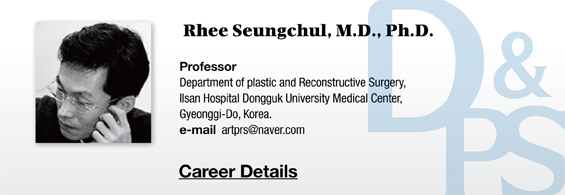
.jpg)
Image 2. Set of eyes measurements in my experiment.
As shown in Image 2, the average ratio or relative value in set of eyes found in Koreans is 42.32%, and that in attractive Korean faces was 44.99%. Especially, this ratio was 45.41% in attractive Asian faces. We can find that attractive faces tend to have rather wide set of eyes. This was similar in Caucasians and Blacks, with attractive female faces having relatively wide set of eyes (Caucasian: 44.9% <46.34%, Black: 46.6% <48.65%).
We can notice the fact that attractive eyes had wide set of eyes in respect to eyes of average faces. We usually know that set of eyes cannot be easily modified by simple plastic surgery. However, my research findings indicate that the facial width also plays an important role in the perception or configuration of the attractiveness eyes and we must not analyze eyes alone for preoperative evaluation. We can also infer that narrowing or widening the facial width can often change the beauty configuration or shape of patients’ eyes.
Differences in the intercanthal distance
The point or fiducial of the medial canthus refers to the most inner corner of both eyes. Measuring the distance between two points of medial canthus (It is usually called as ‘intercanthal distance’) reveals racial and ethnic characteristic differences. The measurements are presented in Image 3.
.jpg)
Image 3. Measurements of intercanthal distance among different faces.
The measured intercanthal distance was 37.67 mm in average Korean women and 35.40mm in attractive Korean women. It was 36.03mm, 31.62mm, 31.04mm, 32.32mm, and 33.00mm in an attractive Asian face, average Caucasian face, attractive Caucasian face, average Black face and attractive Black face, respectively.
[Advertisement] MAGNUM(Q-switched Nd:YAG Laser) – Manufacturer: (www.i-dana.com)]
Caucasians and Blacks tended to have a smaller intercanthal distance compared to Asians, showing race-specific differences. Outside Asia, the surgery of medial epicanthoplastsy or removal of Mongolian folds of eyes is rarely performed but it is regarded as an almost essential part of the double eyelid surgery in Korea.
The goal of medial epicanthoplasty is to enlarge the eye fissure height, reduce the tension of orbicularis oculi muscle of upper eyelid, and define the medial line of the eyelid crease more clearly. From my research, I found that the intercanthal distance of attractive Korean faces was 1.5~2mm smaller than that of an average Korean face. These result shows that reducing the intercanthal distance with medial epicanthoplasty (when it is necessary) can effectively make the eyes appear more attractive.
For Koreans, I have frequently experienced, without medical epicanthoplasty, medial line of double fold is prone to be disappeared as time goes by from excessive tension or forces of orbicularis oculi muscle around Mongolian folds. Accordingly, photogrammetric characteristics of intercanthal discance and the medial shape of eyes must be carefully inspected before embarking blepharoplasty for Asian peoples. It is somewhat different and peculiar characteristics of Asian blepharoplasty, which can be often neglected by surgeons outside Asia.
-To be continued




















